Which Statements About the Life or Art of Sofonisba Anguissola Are True?

Portrait of Elizabeth I of England in her coronation robes. Copy c. 1600–1610 of a lost original of c. 1559.[1] The pose echoes the famous portrait of Richard Ii in Westminster Abbey, the 2nd known portrait of a British sovereign.
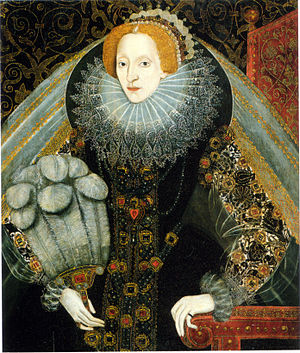
1 of many portraits of its type, with a reversed Darnley face up pattern, c. 1585–xc, creative person unknown
The portraiture of Elizabeth I spans the evolution of English language imperial portraits in the early mod flow (1400/1500-1800), depicting Queen Elizabeth I of England and Ireland (1533–1603), from the primeval representations of unproblematic likenesses to the later complex imagery used to convey the power and aspirations of the state, besides as of the monarch at its head.
Even the earliest portraits of Elizabeth I contain symbolic objects such equally roses and prayer books that would have carried meaning to viewers of her day. Subsequently portraits of Elizabeth layer the iconography of empire—globes, crowns, swords and columns—and representations of virginity and purity, such as moons and pearls, with classical allusions, to present a complex "story" that conveyed to Elizabethan era viewers the majesty and significance of the 'Virgin Queen'.
Overview [edit]

Elizabeth "in blacke with a hoode and cornet", the Clopton Portrait, c. 1558–60
Portraiture in Tudor England [edit]
Two portraiture traditions had arisen in the Tudor courtroom since the days of Elizabeth's father, Henry Eight. The portrait miniature developed from the illuminated manuscript tradition. These small personal images were near invariably painted from life over the space of a few days in watercolours on vellum, stiffened by being glued to a playing menu. Panel paintings in oils on prepared wood surfaces were based on preparatory drawings and were unremarkably executed at life size, as were oil paintings on canvas.
Different her contemporaries in France, Elizabeth never granted rights to produce her portrait to a unmarried creative person, although Nicholas Hilliard was appointed her official limner, or miniaturist and goldsmith. George Gower, a fashionable court portraitist created Serjeant Painter in 1581, was responsible for approving all portraits of the queen created by other artists from 1581 until his death in 1596.[ii]
Elizabeth saturday for a number of artists over the years, including Hilliard, Cornelis Ketel, Federico Zuccaro or Zuccari, Isaac Oliver, and well-nigh probable to Gower and Marcus Gheeraerts the Younger.[ii] Portraits were commissioned by the regime equally gifts to foreign monarchs and to show to prospective suitors. Courtiers deputed heavily symbolic paintings to demonstrate their devotion to the queen, and the fashionable long galleries of subsequently Elizabethan country houses were filled with sets of portraits. The studios of Tudor artists produced images of Elizabeth working from approved "face patterns", or approved drawings of the queen, to meet this growing demand for her image, an important symbol of loyalty and reverence for the crown in times of turbulence.[2]
European context [edit]

A copy of Holbein's Whitehall Mural.
By far the most impressive models of portraiture bachelor to English portraitists were the many portraits past Hans Holbein the Younger, the outstanding Northern portraitist of the commencement one-half of the 16th century, who had made two lengthy visits to England, and had been Henry Eight'south court artist. Holbein had accustomed the English court to the total-length life-size portrait,[three] [a] although none of his originals now survive. His great dynastic mural at Whitehall Palace, destroyed in 1698, and perhaps other original large portraits, would have been familiar to Elizabethan artists.[b]
Both Holbein and his great Italian contemporary Titian had combined bully psychological penetration with a sufficiently majestic impression to satisfy their royal patrons. By his 2nd visit, Holbein had already begun to motility away from a strictly realist delineation; in his Jane Seymour, "the figure is no longer seen as displacing with its bulk a recognizable section of infinite: it approaches rather to a flat pattern, fabricated alive by a bounding and vital outline".[four] This trend was to exist taken much further by the afterward portraits of Elizabeth, where "Likeness of characteristic and an interest in form and volume take gradually been abased in favour of an effect of fantabulous majesty obtained past decorative pattern, and the forms have been flattened accordingly".[v]

Mary I, Anthonis Mor, 1554

Eleanor of Toledo and her son Giovanni, Bronzino, 1545

Titian's full-length portrait of Philip II
Titian connected to pigment regal portraits, especially of Philip 2 of Spain, until the 1570s, but in sharply reduced numbers after about 1555, and he refused to travel from Venice to do them.[6] The full-length portrait of Philip (1550–51) at present in the Prado was sent to Elizabeth's elder sis and predecessor Mary I in accelerate of their spousal relationship.[c]
Towards the mid-16th century, the near influential Continental courts came to adopt less revealing and intimate works,[ix] and at the mid-century the ii virtually prominent and influential royal portraitists in paint, other than Titian, were the Netherlandish Anthonis Mor and Agnolo Bronzino in Florence, as well whom the Habsburg court sculptor and medallist Leone Leoni was similarly skilled. Mor, who had risen chop-chop to prominence in 1540s, worked beyond Europe for the Habsburgs in a tighter and more than rigid version of Titian's compositional style, drawing besides on the North Italian style of Moretto.[10] Mor had really visited London in 1554, and painted three versions of his well-known portrait of Queen Mary; he also painted English courtiers who visited Antwerp.[11] [d]
Mor'southward Spanish educatee Alonso Sánchez Coello continued in a stiffer version of his chief's style, replacing him every bit Spanish court painter in 1561. Sofonisba Anguissola had painted in an intimately breezy style, merely after her recruitment to the Castilian courtroom as the Queen'south painter in 1560 was able to adapt her style to the much more formal demands of land portraiture. Moretto's pupil Giovanni Battista Moroni was Mor's contemporary and formed his mature way in the 1550s, but few of his spirited portraits were of royalty, or even so to exist seen outside Italy.[east]
Bronzino developed a style of coldly distant magnificence, based on the Mannerist portraits of Pontormo, working most entirely for Cosimo I, the beginning Medici Grand-Knuckles.[f] Bronzino's works, including his striking portraits of Cosimo's Duchess, Eleanor of Toledo were distributed in many versions across Europe, continuing to be made for two decades from the same studio pattern; a new portrait painted in her concluding years, about 1560, exists in only a few repetitions. At the least many of the foreign painters in London are probable to have seen versions of the earlier type, and there may well take been one in the Royal Collection.
French portraiture remained dominated by pocket-sized just finely fatigued bust-length or half-length works, including many drawings, often with colour, by François Clouet post-obit, with a host of imitators, his begetter Jean, or even smaller oils past the Netherlandish Corneille de Lyon and his followers, typically no taller than a paperback volume. A few full-length portraits of royalty were produced, dependent on German or Italian models.[xiv]
Creating the royal epitome [edit]

Elizabeth Tudor every bit a Princess, c. 1546, by an unknown creative person.
William Gaunt contrasts the simplicity of the 1546 portrait of Elizabeth Tudor as a Princess with later images of her as queen. He wrote, "The painter...is unknown, but in a competently Flemish style he depicts the daughter of Anne Boleyn as quiet and studious-looking, ornament in her attire as secondary to the plainness of line that emphasizes her youth. Great is the contrast with the awesome fantasy of the later portraits: the pallid, mask-similar features, the extravagance of headdress and ruff, the padded ornateness that seemed to exclude all humanity."[fifteen]
The lack of accent given to depicting depth and volume in her after portraits may take been influenced by the Queen'south ain views. In the Art of Limming, Hilliard cautioned against all just the minimal use of chiaroscuro modelling seen in his works, reflecting the views of his patron: "seeing that all-time to prove oneself needeth no shadow of place only rather the open light...Her Majesty..chose her place to sit for that purpose in the open aisle of a goodly garden, where no tree was well-nigh, nor any shadow at all..."[xvi]
From the 1570s, the government sought to manipulate the image of the queen as an object of devotion and veneration. Sir Roy Stiff writes: "The cult of Gloriana was skilfully created to buttress public social club and, even more, deliberately to replace the pre-Reformation externals of religion, the cult of the Virgin and saints with their attendant images, processions, ceremonies and secular rejoicing."[17] The pageantry of the Accession Day tilts, the poetry of the courtroom, and the most iconic of Elizabeth'south portraits all reflected this try. The management of the queen's prototype reached its heights in the final decade of her reign, when realistic images of the aging queen were replaced with an eternally youthful vision, defying the reality of the passage of time.
Early on portraits [edit]
The young queen [edit]
Portraits of the young queen, many of them likely painted to be shown to prospective suitors and strange heads of state, show a naturality and restraint like to that of the portrait of Elizabeth as a princess.

The Hampden Portrait of Elizabeth I, 1560s
The full-length Hampden image of Elizabeth in a reddish satin gown, originally attributed to Steven van der Meulen and reattributed to George Gower in 2020,[18] has been identified by Sir Roy Potent every bit an important early portrait, "undertaken at a time when her prototype was beingness tightly controlled", and produced "in response to a crisis over the product of the royal image, ane which was reflected in the words of a draft proclamation dated 1563".[nineteen] The draft proclamation (never published) was a response to the circulation of poorly-fabricated portraits in which Elizabeth was shown "in blacke with a hoode and cornet", a style she no longer wore.[20] [g] Symbolism in these pictures is in keeping with before Tudor portraiture; in some, Elizabeth holds a book (perhaps a prayer book) suggesting studiousness or piety. In other paintings, she holds or wears a cherry-red rose, symbol of the Tudor Dynasty's descent from the Firm of Lancaster, or white roses, symbols of the Firm of York and of maidenly chastity.[21] In the Hampden portrait, Elizabeth wears a carmine rose on her shoulder and holds a gillyflower in her hand. Of this image, Stiff says "Hither Elizabeth is caught in that brusk-lived period earlier what was a recognisable human became transmuted into a goddess".[19] [h]
One artist active in Elizabeth'southward early courtroom was the Flemish miniaturist Levina Teerlinc, who had served as a painter and gentlewoman to Mary I and stayed on as a Gentlewoman of the Privy Chamber to Elizabeth. Teerlinc is all-time known for her pivotal position in the ascent of the portrait miniature. In that location is documentation that she created numerous portraits of Elizabeth I, both individual portraits and portraits of the sovereign with of import court figures, but only a few of these take survived and been identified.[23]
Elizabeth and the goddesses [edit]

Elizabeth I and the Three Goddesses, 1569
Two surviving allegorical paintings show the early use of classical mythology to illustrate the beauty and sovereignty of the young queen. In Elizabeth I and the Three Goddesses (1569), attributed to Hans Eworth,[i] the story of the Judgement of Paris is turned on its head. Elizabeth, rather than Paris, is now sent to cull among Juno, Venus, and Pallas-Minerva, all of whom are outshone past the queen with her crown and majestic orb. As Susan Doran writes, "Implicit to the theme of the painting ... is the idea that Elizabeth's memory of royal ability benefits her realm. Whereas Paris's judgement in the original myth resulted in the long Trojan Wars 'to the utter ruin of the Trojans', hers will conversely bring peace and order to the land"[26] after the turbulent reign of Elizabeth's sis Mary I.
The latter theme lies behind the 1572 The Family unit of Henry 8: An Allegory of the Tudor Succession (attributed to Lucas de Heere). In this prototype, Catholic Mary and her husband Philip 2 of Spain are accompanied past Mars, the god of War, on the left, while Protestant Elizabeth on the right ushers in the goddesses Peace and Plenty.[27] An inscription states that this painting was a souvenir from the queen to Francis Walsingham as a "Mark of her people's and her own content", and this may indicate that the painting commemorates the signing of the Treaty of Blois (1572), which established an alliance betwixt England and French republic confronting Spanish aggression in the netherlands during Walsingham'southward tour of duty every bit administrator to the French court.[28] Potent identifies both paintings as celebrations of Elizabeth's only rule by Flemish exiles, to whom England was a refuge from the religious persecution of Protestants in the Spanish Netherlands.[25]
Hilliard and the queen [edit]

Miniature by Hilliard, 1572
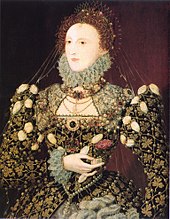
The Phoenix Portrait, c. 1575, attributed to Hilliard

Emmanuel College charter, 1584
Nicholas Hilliard was an amateur to the Queen's jeweller Robert Brandon,[29] a goldsmith and metropolis chamberlain of London, and Strong suggests that Hilliard may likewise have been trained in the art of limning past Levina Teerlinc.[29] Hilliard emerged from his apprenticeship at a time when a new royal portrait painter was "badly needed."[29]
Hilliard's first known miniature of the Queen is dated 1572. Information technology is not known when he was formally appointed limner (miniaturist) and goldsmith to Elizabeth,[30] though he was granted the reversion of a lease past the Queen in 1573 for his "good, true and loyal service."[31] Two panel portraits long attributed to him, the Phoenix and Pelican portraits, are dated c. 1572–76. These paintings are named subsequently the jewels the queen wears, her personal badges of the pelican in her piety and the phoenix. National Portrait Gallery researchers announced in September 2010 that the two portraits were painted on wood from the same two trees; they also found that a tracing of the Phoenix portrait matches the Pelican portrait in reverse, deducing that both pictures of Elizabeth in her forties were painted effectually the same fourth dimension.[32]
However, Hilliard's console portraits seem to have been institute wanting at the time, and in 1576 the recently married Hilliard left for France to meliorate his skills. Returning to England, he continued to work as a goldsmith, and produced some spectacular "picture boxes" or jewelled lockets for miniatures: the Armada Jewel, given by Elizabeth to Sir Thomas Heneage and the Drake Pendant given to Sir Francis Drake are the all-time known examples. As part of the cult of the Virgin Queen, courtiers were expected to wear the Queen'due south likeness, at least at Court.
Hilliard's appointment equally miniaturist to the Crown included the sometime sense of a painter of illuminated manuscripts and he was commissioned to decorate important documents, such as the founding lease of Emmanuel Higher, Cambridge (1584), which has an enthroned Elizabeth under a awning of estate within an elaborate framework of Flemish-style Renaissance strapwork and grotesque ornament. He also seems to have designed woodcut title-folio frames and borders for books, some of which bear his initials.[33]
The Darnley Portrait [edit]

The Darnley Portrait, c. 1575
The trouble of an official portrait of Elizabeth was solved with the Darnley Portrait.[j] Likely painted from life around 1575–6, this portrait is the source of a face design which would be used and reused for authorized portraits of Elizabeth into the 1590s, preserving the impression of ageless beauty. Strong suggests that the artist is Federico Zuccari or Zucaro, an "eminent" Italian creative person, though non a specialist portrait-painter, who is known to accept visited the courtroom briefly with a letter of introduction to Elizabeth'south favourite Robert Dudley, 1st Earl of Leicester, dated five March 1575.[35] Zuccaro'south preparatory drawings for full-length portraits of both Leicester and Elizabeth survive, although it is unlikely the full-length of Elizabeth was ever painted.[35] Curators at the National Portrait Gallery believe that the attribution of the Darnley portrait to Zuccaro is "non sustainable", and attribute the work to an unknown "continental" (perhaps Netherlandish) artist.[36]
The Darnley Portrait features a crown and sceptre on a table beside the queen, and was the start advent of these symbols of sovereignty separately used as props (rather than worn and carried) in Tudor portraiture, a theme that would be expanded in later portraits.[35] Recent conservation piece of work has revealed that Elizabeth's now-iconic pale complexion in this portrait is the result of deterioration of crimson lake pigments, which has also altered the coloring of her dress.[37] [38]
The Virgin Empress of the Seas [edit]
Render of the Gilded Age [edit]

The Ermine Portrait, variously attributed to William Segar or George Gower, 1585.[18] Elizabeth every bit Pax (lit., "peace").
The excommunication of Elizabeth past Pope Pius Five in 1570 led to increased tension with Philip II of Kingdom of spain, who championed the Cosmic Mary, Queen of Scots, equally the legitimate heir of his tardily wife Mary I. This tension played out over the adjacent decades in the seas of the New World besides equally in Europe, and culminated in the invasion attempt of the Spanish Armada.
It is confronting this backdrop that the first of a long series of portraits appears, depicting Elizabeth with heavy symbolic overlays of the possession of an empire based on mastery of the seas.[39] Combined with a second layer of symbolism representing Elizabeth as the Virgin Queen, these new paintings signify the manipulation of Elizabeth's image every bit the destined Protestant protector of her people.[ citation needed ]
Stiff points out that at that place is no trace of this iconography in portraits of Elizabeth prior to 1579, and identifies its source as the conscious image-making of John Dee, whose 1577 General and Rare Memorials Pertayning to the Perfect Arte of Navigation encouraged the establishment of English colonies in the New Globe supported past a potent navy, asserting Elizabeth's claims to an empire via her supposed descent from Brutus of Troy and Male monarch Arthur.[forty]
Dee'southward inspiration lies in Geoffrey of Monmouth's History of the Kings of Great britain, which was accepted every bit true history by Elizabethan poets,[ citation needed ] and formed the basis of the symbolic history of England. In this twelfth-century pseudohistory, Britain was founded by and named afterwards Brutus, the descendant of Aeneas, who founded Rome. The Tudors, of Welsh descent, were heirs of the most ancient Britons and thus of Aeneas and Brutus. By uniting the Houses of York and Lancaster post-obit the strife of the Wars of the Roses, the Tudors ushered in a united realm where Pax - Latin for "peace", and the Roman goddess of peace - reigned.[41] The Spenserian scholar Edwin Greenlaw states "The descent of the Britons from the Trojans, the linking of Arthur, Henry Eight, and Elizabeth as Britain's greatest monarchs, and the return under Elizabeth of the Gold Age are all commonplaces of Elizabethan thought."[42] This agreement of history and Elizabeth'southward place in information technology forms the background to the symbolic portraits of the latter half of her reign.
The Virgin Queen [edit]

A series of Sieve Portraits copied the Darnley confront pattern, and added an allegorical overlay that depicted Elizabeth equally Tuccia, a Vestal Virgin who proved her chastity by carrying a sieve full of water from the Tiber River to the Temple of Vesta without spilling a drop.[43] The outset Sieve Portrait was painted by George Gower in 1579, only the about influential image is the 1583 version by Quentin Metsys (or Massys) the Younger.[thousand]

In the Metsys version, Elizabeth is surrounded by symbols of empire, including a column and a globe, iconography that would announced again and once again in her portraiture of the 1580s and 1590s, about notably in the Armada Portrait of c. 1588.[45] The medallions on the pillar to the left of the queen illustrate the story of Dido and Aeneas, ancestor of Brutus, suggesting that similar Aeneas, Elizabeth's destiny was to reject union and found an empire. This painting's patron was likely Sir Christopher Hatton, as his heraldic badge of the white hind appears on the sleeve of i of the courtiers in the background, and the work may have expressed opposition to the proposed marriage of Elizabeth to François, Knuckles of Anjou.[46] [47]
The virgin Tuccia was familiar to Elizabethan readers from Petrarch'southward "The Triumph of Chastity". Some other symbol from this work is the spotless ermine, wearing a collar of gold studded with topazes.[48] This symbol of purity appears in the Ermine Portrait of 1585, attributed to the herald William Segar. The queen bears the olive branch of Pax (Peace), and the sword of justice rests on the table at her side.[49] In combination, these symbols correspond not merely the personal purity of Elizabeth but the "righteousness and justice of her regime."[l]
Visions of empire [edit]
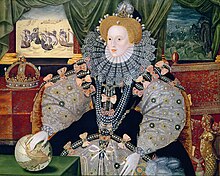
The Woburn Abbey version of the Armada Portrait, c. 1588
The Armada Portrait is an allegorical console painting depicting the queen surrounded by symbols of empire against a properties representing the defeat of the Castilian Fleet in 1588.
There are three surviving versions of the portrait, in addition to several derivative paintings. The version at Woburn Abbey, the seat of the Dukes of Bedford, was long accustomed equally the piece of work of George Gower, who had been appointed Serjeant Painter in 1581.[51] A version in the National Portrait Gallery, London, which had been cutting down at both sides leaving only a portrait of the queen, was also formerly attributed to Gower. A third version, owned by the Tyrwhitt-Drake family, may have been commissioned by Sir Francis Drake. Scholars hold that this version is by a different manus, noting distinctive techniques and approaches to the modelling of the queen's features.[51] [52] [l] Curators now believe that the iii extant versions are all the output of different workshops under the management of unknown English language artists.[54]
The combination of a life-sized portrait of the queen with a horizontal format is "quite unprecedented in her portraiture",[51] although allegorical portraits in a horizontal format, such every bit Elizabeth I and the Three Goddesses and the Family of Henry Eight: An Allegory of the Tudor Succession pre-date the Armada Portrait.

Engraving by Crispijn van de Passe, printed 1596
The queen's paw rests on a globe below the crown of England, "her fingers covering the Americas, indicating England'south [command of the seas] and [dreams of establishing colonies] in the New World".[55] [56] The Queen is flanked by two columns behind, probably a reference to the famous impresa of the Holy Roman Emperor, Charles V, Philip II of Spain'southward father, which represented the pillars of Hercules, gateway to the Atlantic Ocean and the New World.[57]
In the background view on the left, English language fireships threaten the Spanish armada, and on the right the ships are driven onto a rocky coast amid stormy seas by the "Protestant Wind". On a secondary level, these images show Elizabeth turning her dorsum on storm and darkness while sunlight shines where she gazes.[51]
An engraving by Crispijn van de Passe (Crispin van de Passe) published in 1596, merely showing costume of the 1580s, carries similar iconography. Elizabeth stands between ii columns bearing her arms and the Tudor heraldic badge of a portcullis. The columns are surmounted by her emblems of a pelican in her piety and a phoenix, and ships make full the bounding main behind her.[58]
The cult of Elizabeth [edit]

The various threads of mythology and symbolism that created the iconography of Elizabeth I combined into a tapestry of immense complication in the years following the defeat of the Castilian Armada. In poetry, portraiture and pageantry, the queen was celebrated as Astraea, the merely virgin, and simultaneously as Venus, the goddess of beloved. Another exaltation of the queen's virgin purity identified her with the moon goddess, who held rule over the waters. Sir Walter Raleigh had begun to utilise Diana, and afterward Cynthia, as aliases for the queen in his poetry around 1580, and images of Elizabeth with jewels in the shape of crescent moons or the huntress'due south arrows begin to announced in portraiture around 1586 and multiply through the balance of the reign.[59] Courtiers wore the image of the Queen to signify their devotion, and had their portraits painted wearing her colours of black and white.[60]
The Ditchley Portrait seems to take always been at the Oxfordshire domicile of Elizabeth's retired Champion, Sir Henry Lee of Ditchley, and likely was painted for (or commemorates) her two-day visit to Ditchley in 1592. The painting is attributed to Marcus Gheerearts the Younger, and was almost certainly based on a sitting arranged by Lee, who was the painter's patron. In this image, the queen stands on a map of England, her feet on Oxfordshire. The painting has been trimmed and the background poorly repainted, then that the inscription and sonnet are incomplete. Storms rage behind her while the sun shines before her, and she wears a jewel in the form of a celestial or armillary sphere shut to her left ear. Many versions of this painting were made, likely in Gheeraerts' workshop, with the allegorical items removed and Elizabeth's features "softened" from the stark realism of her face in the original. Ane of these was sent every bit a diplomatic gift to the Grand Knuckles of Tuscany, and is now in the Palazzo Pitti.[61]
The last sitting and the Mask of Youth [edit]

The unfinished miniature by Isaac Oliver, c. 1592

Recently discovered miniature by Hilliard, 1595–1600
Around 1592, the queen also sat to Isaac Oliver, a pupil of Hilliard, who produced an unfinished portrait miniature used as a blueprint for engravings of the queen. But a single finished miniature from this pattern survives, with the queen's features softened, and Strong concludes that this realistic image from life of the crumbling Elizabeth was not accounted a success.[62]
Prior to the 1590s, woodcuts and engravings of the queen were created every bit book illustrations, but in this decade individual prints of the queen showtime appear, based on the Oliver face up pattern. In 1596, the Privy Quango ordered that unseemly portraits of the queen which had acquired her "peachy offence" should be sought out and burnt, and Strong advise that these prints, of which comparatively few survive, may be the offending images. Strong writes "It must accept been exposure to the searching realism of both Gheeraerts and Oliver that provoked the decision to suppress all likenesses of the queen that depicted her as being in any style sometime and hence subject to mortality."[63]
In any event, no surviving portraits dated between 1596 and Elizabeth'due south death in 1603 show the aging queen as she truly was. True-blue resemblance to the original is only to be found in the accounts of contemporaries, as in the report written in 1597 by André Hurault de Maisse, Ambassador Extraordinary from Henry IV of French republic, after an audience with the sixty-five year-old queen, during which he noted, "her teeth are very yellow and diff ... and on the left side less than on the right. Many of them are missing, so that i cannot understand her hands when she speaks quickly." All the same he added, "her figure is fair and tall and graceful in whatsoever she does; and so far as may be she keeps her nobility, yet humbly and graciously withal."[64] All subsequent images rely on a face pattern devised by Nicholas Hilliard sometime in the 1590s called by art historians the "Mask of Youth", portraying Elizabeth equally ever-young.[63] [65] Some 16 miniatures by Hilliard and his studio are known based on this confront blueprint, with different combinations of costume and jewels likely painted from life, and it was also adopted by (or enforced on) other artists associated with the Court.[63]
The coronation portraits [edit]

Two portraits of Elizabeth in her coronation robes survive, both dated to 1600 or shortly thereafter. One is a panel portrait in oils, and the other is a miniature by Nicholas Hilliard.[66] The warrant to the queen'southward tailor for remodelling Mary I's cloth of aureate coronation robes for Elizabeth survives, and costume historian Janet Arnold's report points out that the paintings accurately reflect the written records, although the jewels differ in the two paintings,[ane] suggesting two different sources, 1 possibly a miniature past Levina Teerlinc. It is not known why, and for whom, these portraits were created, at, or only after, the end of her reign.[67]
The Rainbow Portrait [edit]

The Rainbow Portrait, c. 1600–02, attributed to Marcus Gheeraerts the Younger
Attributed to Marcus Gheeraerts the Younger,[68] perhaps the most heavily symbolic portrait of the queen is the Rainbow Portrait at Hatfield House. It was painted around 1600–1602, when the queen was in her sixties. In this painting, an ageless Elizabeth appears dressed equally if for a masque, in a linen bodice embroidered with spring flowers and a pall draped over one shoulder, her hair loose beneath a fantastical headdress.[69] She wears symbols out of the popular emblem books, including the cloak with eyes and ears, the snake of wisdom, and the celestial armillary sphere, and carries a rainbow with the motto non sine sole iris ("no rainbow without the sun"). Strong suggests that the complex "programme" for this image may exist the work of the poet John Davies, whose Hymns to Astraea honouring the queen use much of the same imagery, and suggests it was deputed by Robert Cecil as role of the decor for Elizabeth'southward visit in 1602, when a "shrine to Astraea" featured in the entertainments of what would prove to be the "concluding great festival of the reign".[69] [70]
Books and coins [edit]

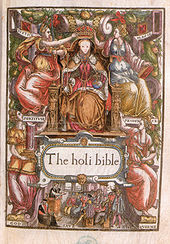
Prior to the broad dissemination of prints of the queen in the 1590s, the common people of Elizabeth's England would be most familiar with her image on the coinage. In December 1560, a systematic recoinage of the debased coin so in circulation was begun. The main early on endeavour was the issuance of sterling silver shillings and groats, but new coins were issued in both silverish and gilt. This restoration of the currency was one of the 3 principal achievements noted on Elizabeth'due south tomb, illustrating the value of stable currency to her contemporaries.[71] Later coinage represented the queen in iconic fashion, with the traditional accompaniments of Tudor heraldic badges including the Tudor rose and portcullis.
Books provided another widely bachelor source of images of Elizabeth. Her portrait appeared on the championship page of the Bishops' Bible, the standard Bible of the Church of England, issued in 1568 and revised in 1572. In diverse editions, Elizabeth is depicted with her orb and sceptre accompanied past female personifications.[72]
"Reading" the portraits [edit]
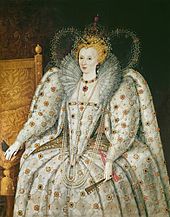
Portrait in the Palazzo Pitti, Florence
The many portraits of Elizabeth I constitute a tradition of prototype highly steeped in classical mythology and the Renaissance agreement of English history and destiny, filtered by allusions to Petrarch's sonnets and, late in her reign, to Edmund Spenser's Faerie Queene. This mythology and symbology, though directly understood by Elizabethan contemporaries for its political and symbolic significant, makes it difficult to 'read' the portraits in the present day every bit contemporaries would have seen them at the time of their creation. Though knowledge of the symbology of Elizabethan portraits has not been lost, Dame Frances Yates points out that the most complexly symbolic portraits may all commemorate specific events, or take been designed equally part of elaborately-themed entertainments, knowledge left unrecorded within the paintings themselves.[47] The nigh familiar images of Elizabeth—the Armada, Ditchley, and Rainbow portraits—are all associated with unique events in this way. To the extent that the contexts of other portraits take been lost to scholars, so too the keys to understanding these remarkable images as the Elizabethans understood them may exist lost in fourth dimension; even those portraits that are not overtly allegorical may have been total of meaning to a discerning eye. Elizabethan courtiers familiar with the language of flowers and the Italian emblem books could have read stories in the flowers the queen carried, the embroidery on her clothes, and the design of her jewels.
According to Strong:
Fright of the wrong use and perception of the visual paradigm dominates the Elizabethan age. The old pre-Reformation idea of images, religious ones, was that they partook of the essence of what they depicted. Any advance in technique which could reinforce that experience was embraced. That was now reversed, indeed information technology may account for the Elizabethans failing to take cognisance of the optical advances which created the art of the Italian Renaissance. They certainly knew about these things but, and this is central to the understanding of the Elizabethans, chose not to employ them. Instead the visual arts retreated in favour of presenting a series of signs or symbols through which the viewer was meant to pass to an understanding of the idea backside the piece of work. In this mode the visual arts were verbalised, turned into a grade of book, a 'text' which called for reading by the onlooker. There are no better examples of this than the quite extraordinary portraits of the queen herself, which increasingly, as the reign progressed, took on the form of collections of abstract pattern and symbols disposed in an unnaturalistic mode for the viewer to unravel, and by doing so enter into an inner vision of the thought of monarchy.[73]
Gallery [edit]
Queen and court [edit]
-

Unknown artist, The Family of Henry Eight, with Elizabeth on the right, c. 1545
-

Elizabeth and the Ambassadors, attributed to Levina Teerlinc, c. 1560
-

An Elizabethan Maundy, miniature by Teerlinc, c. 1560
-

The Family of Henry VIII, an Apologue of the Tudor Succession, 1572, attributed to Lucas de Heere
Portrait miniatures [edit]
-

Teerlinc, c. 1565
-

Hilliard, c. 1580
-

Hilliard, c. 1587
-
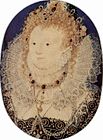
Hilliard, c. 1590
-

Hilliard, 1595–1600
Portraits [edit]
-

Unknown artist, c. 1559
-

c. 1560
-

Unknown artist, 1560–65
-

The Gripsholm Portrait, 1563
-

-

Unknown artist, 1570s
-
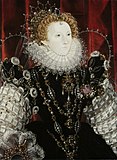
Nicholas Hilliard, c. 1576-78
-

The Schloss Ambras Portrait, unknown artist, 1575–80
-
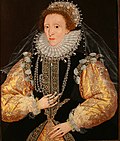
The Drewe Portrait, 1580s, George Gower
-

In Parliament Robes, 1585–90, attributed to Marcus Gheeraerts the Younger
-

Variant of the Armada Portrait, c. 1588
-

Portrait by an unknown artist, c. 1595
-
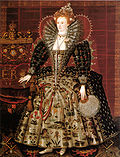
The Hardwick Hall Portrait, the Mask of Youth, Hilliard workshop, c. 1599
Portrait medallions and cameos [edit]
-

Portrait medallion, c. 1572–73, diplomatic gift to Adriaen de Manmaker, appointed Treasurer General of the province of Zeeland on 20 Oct 1573.[74]
-

Sir Francis Drake wearing the Drake Pendant, a cameo of the queen. Gheeraerts the Younger, 1591
Drawings [edit]
-

Preliminary chalk sketch for a portrait of Elizabeth I, Zuccaro, c. 1575
-

Design for the obverse of a Great Seal for Ireland (never fabricated), pen and ink launder over pencil, Hilliard, c. 1584
-

Pen and ink cartoon on vellum by Isaac Oliver, c. 1592–95
Prints and coins [edit]
-

Coloured frontispiece to Christopher Saxton's Atlas of England and Wales, 1579
-

Coloured engraving, Coram Rege curl, 1581
-

Engraving based on the Oliver design of c. 1592
-

Elizabeth as Rosa Electa, Rogers, 1590–95
-

Engraving c. 1592–95 by Crispijn de Passe from the drawing by Oliver, with afterward inscription
-

Irish groat of 1561. Coins were of grade the chief way the mass of her people received images of Elizabeth.
-

Gilded half-pound of 1560–61
Illuminated manuscripts [edit]
-

Illuminated initial membrane, Court of King's Bench: Coram Rege Roll, Easter Term, 1572
-

Coram Rege Curlicue, Easter Term, 1584
-

Charter of Queen Elizabeth's Grammar School, Ashbourne, Hilliard, 1585
-

Coram Rege Ringlet, Easter Term, 1589
Run into also [edit]
- 1550–1600 in fashion
- Artists of the Tudor Court
- Cultural depictions of Elizabeth I of England
Notes [edit]
- ^ This was in notable contrast to France, in particular, where smaller portraits remained more typical until Henry IV of France came to power in 1594.
- ^ Waterhouse (19–22) points out that just very high ranking persons could enter the room where the mural was displayed when the court was in residence at Whitehall. But artists could probably have gained access during the long periods when the monarch was elsewhere; certainly there are many apparent copies of the effigy of Henry from this piece of work.
- ^ The portrait came from Philip's aunt Mary in Brussels, presumably as a loan.[7] It was presumably returned by or afterward Mary I's decease in 1558, as information technology is in a Spanish royal inventory of 1600.[8] The painting returned to London for an exhibition at the National Gallery until Jan 2009.
- ^ Surviving portraits include those of Sir Thomas Gresham and Sir Henry Lee, who was later to commission the Ditchley Portrait.
- ^ Even in Italy, his best portraits were routinely attributed to Titian or Moretto; for example, what has always been his about famous piece of work, the so-called Titian'south Schoolmaster, now resides in Washington, but was previously displayed in the Palazzo Borghese in Rome.[12]
- ^ In an extended discussion, Michael Levey says Bronzino showed the ducal family "so wrought and congealed that there is cypher of living tissue left in them. Their hands take turned to ivory, and their eyes to pieces of beautifully cut, faceted jet."[13]
- ^ In these portraits Elizabeth may be wearing mourning for her sister Mary; encounter commentary on a portrait (Paradigm) of Mary, Queen of Scots in a similar black gown and French hood with the cornet or bongrace pinned up at "Mary Queen of Scots (1542 - 1587) c. 1558". Historical Portraits Epitome Library. Archived from the original on 16 October 2008. Retrieved 8 Nov 2008. , where the costume is compared to Elizabeth'due south in the Clopton portrait type.
- ^ This portrait was sold at Sotheby'southward, London, for £2.six one thousand thousand in November 2007.[22]
- ^ The portrait is signed "H.East." and the creative person formerly identified as the "Monogrammist H.E." is at present more often than not assumed to be Hans Eworth.[24] Strong had earlier attributed the painting to Joris Hoefnagel.[25]
- ^ So-called from its location at Cobham House, much after the seat of the Earls of Darnley.[34]
- ^ Although Potent attributed the painting to Cornelis Ketel in 1969 and over again in 1987,[44] closer test has revealed that the painting is signed and dated on the base of the globe 1583. Q. MASSYS
- ^ This version was heavily overpainted in the later 17th century, which complicates attribution and may account for several differences in details of the costume.[53]
References [edit]
- ^ a b Arnold 1978
- ^ a b c Stiff 1987, pp. 14–fifteen
- ^ Waterhouse (1978), pp. 25–six.
- ^ Waterhouse:19
- ^ Waterhouse, p. 36
- ^ Fletcher, Jennifer in: David Jaffé (ed), Titian, pp. 31–ii, The National Gallery Company/Yale, London 2003, ISBN i-85709-903-6
- ^ Fletcher, op. cit. pp. 31 and 148
- ^ Prado:398–99 (#411)
- ^ For assay of this trend see Levey (1971), Ch. 3, and Trevor-Roper (1976) Ch. ane and two.
- ^ Waterhouse (1978), pp. 27–8. For his relationship with the Habsburgs, encounter Trevor-Roper (1976) passim, who as well covers those of Leone Leoni and Titian in detail.
- ^ Waterhouse (1978), p. 28.
- ^ Penny:194–five on his life and style, 196–7 on his reputation. Freedberg (1993), pp. 593–five analyses his portrait style.
- ^ Levey (1971), pp. 96–108 — quotation from p. 108. Encounter also Freedberg (1993), pp. 430–35
- ^ Blunt, pp. 62–64
- ^ Gaunt, 37.
- ^ Quotation from Hilliard'south Art of Limming, c. 1600, in Nicholas Hilliard, Roy Stiff, 1975, p.24, Michael Joseph Ltd, London, ISBN 0-7181-1301-2
- ^ Strong 1977, p. xvi
- ^ a b Boondocks, Edward; David, Jessica (1 September 2020). "George Gower: portraitist, Mercer, Serjeant Painter". The Burlington Magazine. 162 (1410): 731–747.
- ^ a b "Portrait of a royal quest for a husband". The Independent, (London), Nov i, 2007. Retrieved on 24 Oct 2008.
- ^ Strong 1987, p. 23
- ^ Doran 2003b, p. 177
- ^ Reuters news story
- ^ Strong 1987, pp. 55–57
- ^ Hearn 1995, p. 63
- ^ a b Strong 1987, p. 42
- ^ Doran 2003b, p. 176
- ^ Hearn 1995, pp. 81–82
- ^ Doran 2003b, pp.185–86
- ^ a b c Potent 1987, p. 79–83
- ^ Reynolds, Hilliard and Oliver, pp. eleven–18
- ^ Strong 1975, p.four
- ^ Pelican and Phoenix inquiry
- ^ Strong, 1983, pp. 62 & 66
- ^ run into Strong 1987 p. 86
- ^ a b c Strong 1987, p.85
- ^ Cooper and Bolland (2014), p. 147
- ^ Cooper and Bolland (2014), pp. 162-167
- ^ National Portrait Gallery (2014). "Making Art in Tudor Britain: 'Darnley' portrait". Retrieved 28 September 2014.
- ^ Strong 1987, pp. 91–93
- ^ Strong 1987, p. 91
- ^ Yates, pp. 50–51.
- ^ E[dwin] Greenlaw, Studies in Spenser's Historical Allegory, Baltimore, Johns Hopkins Press, 1932, quoted in Yates, p. 50.
- ^ See Hearn 1995, p. 85; Strong 1987, p. 95
- ^ Strong 1987 p. 101
- ^ Hearn, p. 85; Strong 1987 p. 101
- ^ Doran 2003b, p. 187
- ^ a b Yates, p. 115
- ^ Yates pp. 115, 215–216
- ^ Stiff 1987, p. 113
- ^ Yates, p. 216
- ^ a b c d Potent 1987, Gloriana, p. 130–133
- ^ Hearn 1995 p. 88
- ^ See Arnold, Queen Elizabeth'southward Wardrobe Unlock'd, pp. 34–36
- ^ Cooper and Bolland (2014), pp. 151-154
- ^ Hearn 1995, p. 88
- ^ Andrew Belsey and Catherine Belsey, "Icons of Divinity: Portraits of Elizabeth I" in Gent and Llewellyen, Renaissance Bodies, pp. 11–35
- ^ Strong 1984, p. 51
- ^ Strong 1987, p. 104
- ^ Stiff 1987, pp. 125–127
- ^ Strong 1977, pp. 70–75
- ^ Stiff 1987, pp. 135–37.
- ^ Strong 1987, p. 143
- ^ a b c Strong 1987, p. 147
- ^ De Maisse: a periodical of all that was achieved by Monsieur De Maisse, administrator in England from Male monarch Henri Iv to Queen Elizabeth, anno domini 1597, Nonesuch Printing, 1931, p. 25-26
- ^ Sotheby's Catalogue L07123, Important British Paintings 1500–1850, Nov 2007, p. 20
- ^ "Elizabeth I // Miniature Portraits // The Portland Drove".
- ^ Strong 1987, pp. 162–63
- ^ Strong, Roy C. Gloriana: The Portraits of Queen Elizabeth I. Germany: Thames and Hudson, 1987. pg. 148
- ^ a b Strong 1987, pp. 157–160
- ^ Strong 1977, pp. 46–47
- ^ Doran 2003a, p. 52
- ^ Doran 2003a, p. 29
- ^ Strong (1999), p. 177
- ^ "A historical and important English/Dutch 20KT gilt-framed Elizabethan portrait miniature pendant, Christie's". Retrieved half-dozen April 2012. . The Zeeuws Museum dates the medallion to 1572–73.
Bibliography [edit]
- Arnold, Janet: "The 'Coronation' Portrait of Queen Elizabeth I", The Burlington Magazine, CXX, 1978, pp. 727–41.
- Arnold, Janet: Queen Elizabeth's Wardrobe Unlock'd, Westward S Maney and Son Ltd, Leeds 1988. ISBN 0-901286-20-six
- Blunt, Anthony, Art and Architecture in France, 1500–1700, second edn 1957, Penguin
- Cooper, Tarnya; Bolland, Charlotte (2014). The Real Tudors : kings and queens rediscovered. London: National Portrait Gallery. ISBN 9781855144927.
- Freedberg, Sidney J., Painting in Italia, 1500–1600, tertiary edn. 1993, Yale, ISBN 0-300-05587-0
- Gaunt, William: Courtroom Painting in England from Tudor to Victorian Times. London: Constable, 1980. ISBN 0-09-461870-4.
- Gent, Lucy, and Nigel Llewellyn, eds: Renaissance Bodies: The Human Figure in English Culture c. 1540–1660Reaktion Books, 1990, ISBN 0-948462-08-6
- Hearn, Karen, ed. Dynasties: Painting in Tudor and Jacobean England 1530–1630. New York: Rizzoli, 1995. ISBN 0-8478-1940-X (Hearn 1995)
- Hearn, Karen: Marcus Gheeraerts 2 Elizabeth Creative person, London: Tate Publishing 2002, ISBN one-85437-443-five (Hearn 2002)
- Kinney, Arthur F.: Nicholas Hilliard's "Fine art of Limning", Northeastern University Printing, 1983, ISBN 0-930350-31-6
- Levey, Michael, Painting at Court, Weidenfeld & Nicolson, London, 1971
- Penny, Nicholas, National Gallery Catalogues (new series): The Sixteenth Century Italian Paintings, Volume 1, 2004, National Gallery Publications Ltd, ISBN 1-85709-908-7
- Museo del Prado, Catálogo de las pinturas, 1996, Ministerio de Educación y Cultura, Madrid, ISBN 84-87317-53-seven (Prado)
- Reynolds, Graham: Nicholas Hilliard & Isaac Oliver, Her Majesty's Stationery Office, 1971
- Strong, Roy: The English language Icon: Elizabethan and Jacobean Portraiture, 1969, Routledge & Kegan Paul, London (Strong 1969)
- Strong, Roy: Nicholas Hilliard, 1975, Michael Joseph Ltd, London, ISBN 0-7181-1301-two (Potent 1975)
- Strong, Roy: The Cult of Elizabeth, 1977, Thames and Hudson, London, ISBN 0-500-23263-half-dozen (Strong 1977)
- Stiff, Roy: Artists of the Tudor Court: The Portrait Miniature Rediscovered 1520–1620, Victoria & Albert Museum exhibit catalogue, 1983, ISBN 0-905209-34-6 (Strong 1983)
- Strong, Roy: Art and Ability; Renaissance Festivals 1450–1650, 1984, The Boydell Press;ISBN 0-85115-200-vii (Strong 1984)
- Strong, Roy: "From Manuscript to Miniature" in John Murdoch, Jim Murrell, Patrick J. Apex & Roy Strong, The English Miniature, Yale Academy Press, New Haven and London, 1981 (Stiff 1981)
- Strong, Roy: Gloriana: The Portraits of Queen Elizabeth I, Thames and Hudson, 1987, ISBN 0-500-25098-7 (Strong 1987)
- Strong, Roy: The Spirit of Britain, 1999, Hutchison, London, ISBN ane-85681-534-10 (Strong 1999)
- Trevor-Roper, Hugh; Princes and Artists, Patronage and Ideology at 4 Habsburg Courts 1517–1633, Thames & Hudson, London, 1976, ISBN 0-500-23232-vi
- Waterhouse, Ellis; Painting in Britain, 1530–1790, 4th Edn, 1978, Penguin Books (at present Yale History of Art series)
- Yates, Frances: Astraea: The Imperial Theme in the Sixteenth Century, London and Boston: Routledge and Keegan Paul, 1975, ISBN 0-7100-7971-0
Further reading [edit]
- Connolly, Annaliese, and Hopkins, Lisa (eds.), Goddesses and Queens: The Iconography of Elizabeth, 2007, Manchester University Printing, ISBN 978-0719076770
Source: https://en.wikipedia.org/wiki/Portraiture_of_Elizabeth_I
0 Response to "Which Statements About the Life or Art of Sofonisba Anguissola Are True?"
Post a Comment